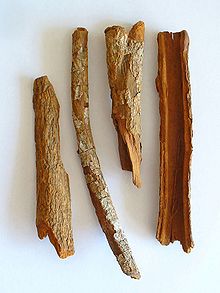cinchona
Jump to navigation
Jump to search
See also: Cinchona
English[edit]

Alternative forms[edit]
Etymology[edit]
From New Latin cinchona, from Spanish Chinchón. Named by Carl Linnaeus after Ana de Osorio, 4th Countess of Chinchón (1599–1625), the wife of the Spanish Viceroy of Peru, who was allegedly cured of a fever by the bark.
Pronunciation[edit]
Noun[edit]
cinchona (countable and uncountable, plural cinchonas)
- A tree or shrub of the genus Cinchona, native to the Andes in South America but since widely cultivated in Indonesia and India as well for its medicinal bark.
- Synonym: quinquina
- 1887, Harriet W. Daly, Digging, Squatting, and Pioneering Life in the Northern Territory of South Australia, page 222:
- He seems to have collected plants of every kind - sugar-cane, coffee, cinchona, cocoa, indigo, and many others - and thus demonstrates beyond a doubt that Arnheim's Land will not prove herself behind the rest of the tropical world both in planting and agriculture, when the labour question is settled, and a properly-arranged coolie system enables planters to give the country a proper trial.
- 2001, Leslie Iversen, Drugs: A Very Short Introduction, Oxford, page 8:
- German chemists were the first to isolate pure drug chemicals from herbal medicines, with the isolation of morphine from crude opium in 1803 and quinine from the bark of the cinchona tree in 1820.
- The bark of these plants, which yield quinine and other alkaloids useful in reducing fevers and particularly in combatting malaria.
- Synonyms: cinchona-bark, Jesuit's bark, Peruvian bark, quinquina
- (medicine) Any medicine chiefly composed of the prepared bark of these plants.
Derived terms[edit]
Related terms[edit]
- cinchonaceae, cinchonaceous
- cinchonamine, cinchonate, cinchonia, cinchonic, cinchonicia, cinchonicine, cinchonidia, cinchonidine
- cinchonic red
Translations[edit]
tree
bark
|
Further reading[edit]
Anagrams[edit]
Categories:
- English terms borrowed from New Latin
- English terms derived from New Latin
- English terms derived from Spanish
- English eponyms
- English 3-syllable words
- English terms with IPA pronunciation
- English lemmas
- English nouns
- English uncountable nouns
- English countable nouns
- English terms with quotations
- en:Medicine
- en:Madder family plants
- en:Pharmaceutical drugs